The ware for this month is shown below:
One of the ideas of name that ware is to learn by taking apart everyday objects. This one came across my desk under unfortunate circumstances, which lead to me dissecting it and snapping a couple photos to share!
Also, in the pantheon of wires I have known, the wire below holds a special place: it was literally part of me for several months. In fact, if you look very closely, you can still see bits of me attached to the wire.
Most interesting is how my body built a custom cable chase for the wire as the bones healed:

Now if I can only get my robots to learn this trick, it’d save me a lot on zip ties…


Seems like a residual-current circuit breaker, possibly combined with overload protection. Non-electronic version, doesn’t trip when leakage has a large DC component (e.g. at some point after the rectifier, bitten me once)
Also, congratulations on needing one less wire to function!
Definitely a breaker/interrupter, but residual-current would use two mains wires to cancel out the current from the load. I think it’s either an earth leakage circuit breaker, or an arc-fault circuit interrupter. I am guessing that the resistor is for powering the device (it is too low-value / high-wattage for an indicator or something), and the black wire is the other mains connection for powering the device. Since I don’t see any connection to the high-current from either the black wire or resistor, it is slightly suggestive that the high-current wire is ground and this is a earth-leakage circuit breaker. That might also be supported by the winding ratio being only 2:1, which would still output ~60VAC if it was meant to typically carry a lot of current.
Scratch my statement about being ~60VAC specifically, since it obviously isn’t going to have the full mains voltage across it unless something is really going wrong.
An additional point in favor of the earth-leakage breaker is that the mechanism looks more like it is to be attached to a line other than the one wound through the inductor, rather than integrated with the wound wire.
The high wattage resistor and the small magnet wire winding are connected to the test switch, which when pressed inject a calibrated current to trip the device.
My guess is a GFCI interrupter, which is a differential current trip. If more current goes out on the line than returns on the neutral, then it is going somewhere possibly dangerous, like through the user to ground.
Now, you are wireless…
There ought to be a “Name That Wire”.
Ten pics of wires and cables. Name them all.
https://en.wikipedia.org/wiki/Residual-current_device#/media/File:FISkizze.svg